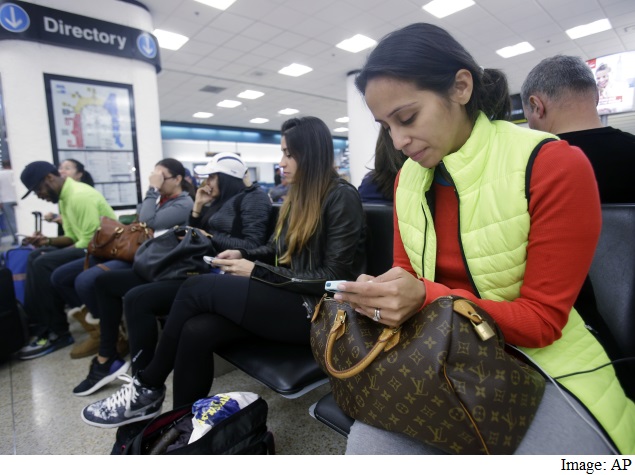- Home
- Social networking
- Social networking Features
- Indian Women Using Social Media to Fight Sexual Harassment
Indian Women Using Social Media to Fight Sexual Harassment

In the latest of a series of incidents, a young Indian woman used her smartphone to shoot video of a man sitting behind her on an IndiGo airline flight who tried to grope her between the seats. She filmed her rebuke of him in front of the other passengers.
The video, posted on YouTube this week, went viral, adding to growing anger over gender violence in the world's second most populous country where women are frequently sexually harassed in public and on transportation.
The trend to name-and-shame sex offenders comes after the gang-rape and murder of a 23-year-old woman on a bus in Delhi in 2012. The incident sparked public protests and led to a national debate about the security of women - encouraging victims once embarrassed to come forward to use smartphones to expose perpetrators.
Interest in safety apps with SOS buttons to alert contacts and websites to report sexual harassment has surged in the past year or so as more women challenge the age-old patriarchal attitudes in India that view women as lower status than men.
"A video is a weapon that scares patriarchy. The proof, like in the IndiGo case, is mostly undeniable," wrote Piyasree Dasgupta, on leading news website firstpost.com.
"It leaves the woman with more power than usual to fight for her own cause with little need of either empathy or logistical help from a man. It pins a man down for his crimes with little scope of escape."
Empowered by social media
The latest video made on a domestic flight by budget airline IndiGo from Mumbai had been seen by 4.4 million viewers as of Thursday morning and sparked outrage across social media.
"Because I'm a girl, and you have the right to touch me anytime, anywhere you want to?" the woman yells at the middle-aged man, who tries to cover his face with his hand.
The man eventually responds, saying he is sorry and asking forgiveness, watched by passengers disembarking the plane.
Upon landing in Bhubaneswar, in eastern Odisha state, the victim lodged a complaint with IndiGo crew and local police, said an airline statement.
The video is the latest of several incidents caught on camera by victims, their friends, and bystanders to show how Indian women and girls are feeling empowered by the use of smartphones and standing up to their aggressors.
In November, two sisters in the city of Rohtak hit the headlines when a video taken by other passengers showed them fighting with three young men who harassed them on a bus in the northern state of Haryana. One of the sisters hits the men with a belt while passengers on the bus watch without intervening.
Another video from the southern city of Bangalore in August showed a female jogger chasing a man who was sexually harassing her, catching up with him and forcing him to the ground. She kicks him and tells him to "get lost".
The same month, in northern Uttar Pradesh state, a video showing girls slapping an aggressor in a market went viral.
Since the fatal gang-rape in Delhi in 2012, the Indian government has tightened laws for crimes against women and introduced tougher penalties, but many Indian women say they feel no safer, according to a recent poll in the Hindustan Times.
There were 309,546 crimes against women reported to the police in 2013, up from 244,270 the previous year, according to the National Crime Records Bureau. These include rape, kidnapping, sexual harassment and molestation.
© Thomson Reuters 2015
Catch the latest from the Consumer Electronics Show on Gadgets 360, at our CES 2026 hub.
Related Stories
- Samsung Galaxy Unpacked 2025
- ChatGPT
- Redmi Note 14 Pro+
- iPhone 16
- Apple Vision Pro
- Oneplus 12
- OnePlus Nord CE 3 Lite 5G
- iPhone 13
- Xiaomi 14 Pro
- Oppo Find N3
- Tecno Spark Go (2023)
- Realme V30
- Best Phones Under 25000
- Samsung Galaxy S24 Series
- Cryptocurrency
- iQoo 12
- Samsung Galaxy S24 Ultra
- Giottus
- Samsung Galaxy Z Flip 5
- Apple 'Scary Fast'
- Housefull 5
- GoPro Hero 12 Black Review
- Invincible Season 2
- JioGlass
- HD Ready TV
- Laptop Under 50000
- Smartwatch Under 10000
- Latest Mobile Phones
- Compare Phones
- Motorola Signature
- Vivo Y50e 5G
- Vivo Y50s 5G
- Realme 16 Pro+ 5G
- Realme 16 Pro 5G
- TCL Nxtpaper 70 Pro
- OPPO A6 Pro 5G
- Honor Power 2
- Lenovo Yoga Slim 7x (2025)
- Lenovo Yoga Slim 7a
- Realme Pad 3
- OPPO Pad Air 5
- Xiaomi Watch 5
- Huawei Watch 10th Anniversary Edition
- Acerpure Nitro Z Series 100-inch QLED TV
- Samsung 43 Inch LED Ultra HD (4K) Smart TV (UA43UE81AFULXL)
- Asus ROG Ally
- Nintendo Switch Lite
- Haier 1.6 Ton 5 Star Inverter Split AC (HSU19G-MZAID5BN-INV)
- Haier 1.6 Ton 5 Star Inverter Split AC (HSU19G-MZAIM5BN-INV)

















